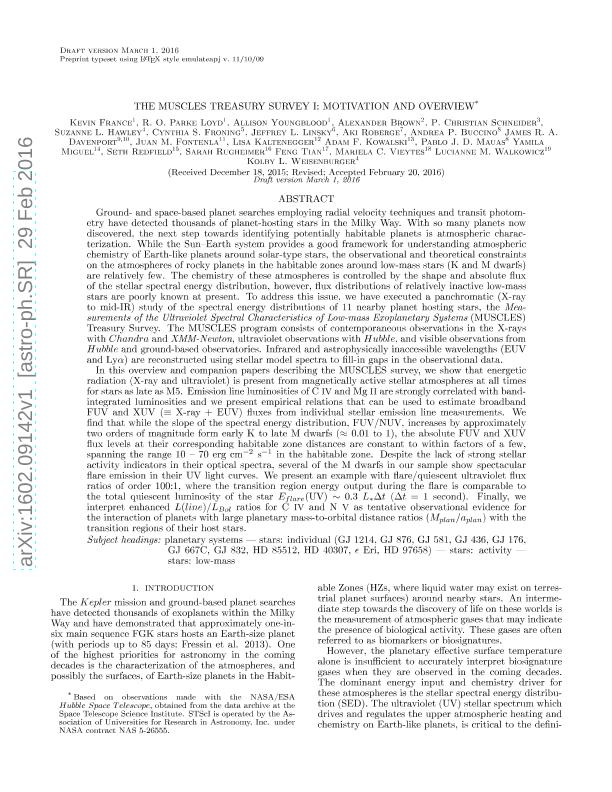Mostrar el registro sencillo del ítem
dc.contributor.author
France, Kevin
dc.contributor.author
Parke Loyd, R. O.
dc.contributor.author
Youngblood, Allison
dc.contributor.author
Brown, Alexander
dc.contributor.author
Schneider, P. Christian
dc.contributor.author
Hawley, Suzanne L.
dc.contributor.author
Froning, Cynthia S.
dc.contributor.author
Linsky, Jeffrey L.
dc.contributor.author
Roberge, Aki
dc.contributor.author
Buccino, Andrea Paola

dc.contributor.author
Davenport, James R. A.
dc.contributor.author
Fontenla, Juan M.
dc.contributor.author
Kaltenegger; Lisa
dc.contributor.author
Kowalski, Adam F.
dc.contributor.author
Mauas, Pablo Jacobo David

dc.contributor.author
Miguel, Yamila

dc.contributor.author
Redfield, Seth
dc.contributor.author
Rugheimer, Sarah
dc.contributor.author
Tian, Feng
dc.contributor.author
Vieytes, Mariela Cristina

dc.contributor.author
Walkowicz, Lucianne M.
dc.contributor.author
Weisenburger, Kolby L.
dc.date.available
2017-08-01T18:21:19Z
dc.date.issued
2016-04
dc.identifier.citation
France, Kevin; Parke Loyd, R. O.; Youngblood, Allison; Brown, Alexander; Schneider, P. Christian; et al.; The MUSCLES Treasury Survey I: Motivation and Overview; IOP Publishing; Astrophysical Journal; 820; 2; 4-2016; 89-113,1-24
dc.identifier.issn
0004-637X
dc.identifier.uri
http://hdl.handle.net/11336/21743
dc.description.abstract
Ground- and space-based planet searches employing radial velocity techniques and transit photometry have detected thousands of planet-hosting stars in the Milky Way. With so many planets discovered, the next step toward identifying potentially habitable planets is atmospheric characterization. While the Sun–Earth system provides a good framework for understanding the atmospheric chemistry of Earth-like planets around solar-type stars, the observational and theoretical constraints on the atmospheres of rocky planets in the habitable zones (HZs) around low-mass stars (K and M dwarfs) are relatively few. The chemistry of these atmospheres is controlled by the shape and absolute flux of the stellar spectral energy distribution (SED), however, flux distributions of relatively inactive low-mass stars are poorly understood at present. To address this issue, we have executed a panchromatic (X-ray to mid-IR) study of the SEDs of 11 nearby planet-hosting stars, the Measurements of the Ultraviolet Spectral Characteristics of Low-mass Exoplanetary Systems (MUSCLES) Treasury Survey. The MUSCLES program consists visible observations from Hubble and ground-based observatories. Infrared and astrophysically inaccessible wavelengths (EUV and Lyα) are reconstructed using stellar model spectra to fill in gaps in the observational data. In this overview and the companion papers describing the MUSCLES survey, we show that energetic radiation (X-ray and ultraviolet) is present from magnetically active stellar atmospheres at all times for stars as late as M6. The emission line luminosities of C IV and Mg II are strongly correlated with band-integrated luminosities and we present empirical relations that can be used to estimate broadband FUV and XUV (≡X-ray + EUV) fluxes from individual stellar emission line measurements. We find that while the slope of the SED, FUV/NUV, increases by approximately two orders of magnitude form early K to late M dwarfs (≈0.01–1), the absolute FUV and XUV flux levels at their corresponding HZ distances are constant to within factors of a few, spanning the range 10–70 erg cm−2 s −1 in the HZ. Despite the lack of strong stellar activity indicators in their optical spectra, several of the M dwarfs in our sample show spectacular UV flare emission in their light curves. We present an example with flare/quiescent ultraviolet flux ratios of the order of 100:1 where the transition region energy output during the flare is comparable to the total quiescent luminosity of the star Eflare(UV) ∼ 0.3 L*Δt (Δt = 1 s). Finally, we interpret enhanced L(line)/LBol ratios for C IV and N V as tentative observational evidence for the interaction of planets with large planetary mass-to-orbital distance ratios (Mplan/aplan) with the transition regions of their host stars.
dc.format
application/pdf
dc.language.iso
eng
dc.publisher
IOP Publishing

dc.rights
info:eu-repo/semantics/openAccess
dc.rights.uri
https://creativecommons.org/licenses/by-nc-sa/2.5/ar/
dc.subject
Planetary Systems
dc.subject
Stars: Activity
dc.subject
Stars: Low-Mass
dc.subject.classification
Astronomía

dc.subject.classification
Ciencias Físicas

dc.subject.classification
CIENCIAS NATURALES Y EXACTAS

dc.title
The MUSCLES Treasury Survey I: Motivation and Overview
dc.type
info:eu-repo/semantics/article
dc.type
info:ar-repo/semantics/artículo
dc.type
info:eu-repo/semantics/publishedVersion
dc.date.updated
2017-07-27T12:48:44Z
dc.journal.volume
820
dc.journal.number
2
dc.journal.pagination
89-113,1-24
dc.journal.pais
Reino Unido

dc.journal.ciudad
Londres
dc.description.fil
Fil: France, Kevin. State University Of Colorado Boulder; Estados Unidos
dc.description.fil
Fil: Parke Loyd, R. O.. State University Of Colorado Boulder; Estados Unidos
dc.description.fil
Fil: Youngblood, Allison. State University Of Colorado Boulder; Estados Unidos
dc.description.fil
Fil: Brown, Alexander. State University Of Colorado Boulder; Estados Unidos
dc.description.fil
Fil: Schneider, P. Christian. European Space Research and Technology Centre; Países Bajos
dc.description.fil
Fil: Hawley, Suzanne L.. University of Washington; Estados Unidos
dc.description.fil
Fil: Froning, Cynthia S.. University of Texas at Austin; Estados Unidos
dc.description.fil
Fil: Linsky, Jeffrey L.. State University Of Colorado Boulder; Estados Unidos
dc.description.fil
Fil: Roberge, Aki. National Aeronautics And Space Administration. Goddart Institute For Space Studies; Estados Unidos
dc.description.fil
Fil: Buccino, Andrea Paola. Consejo Nacional de Investigaciónes Científicas y Técnicas. Oficina de Coordinación Administrativa Ciudad Universitaria. Instituto de Astronomía y Física del Espacio. - Universidad de Buenos Aires. Facultad de Ciencias Exactas y Naturales. Instituto de Astronomía y Física del Espacio; Argentina
dc.description.fil
Fil: Davenport, James R. A.. Western Washington University; Estados Unidos
dc.description.fil
Fil: Fontenla, Juan M.. Northwest Research Associates; Estados Unidos
dc.description.fil
Fil: Kaltenegger; Lisa. Cornell University; Estados Unidos
dc.description.fil
Fil: Kowalski, Adam F.. University of Maryland; Estados Unidos
dc.description.fil
Fil: Mauas, Pablo Jacobo David. Consejo Nacional de Investigaciónes Científicas y Técnicas. Oficina de Coordinación Administrativa Ciudad Universitaria. Instituto de Astronomía y Física del Espacio. - Universidad de Buenos Aires. Facultad de Ciencias Exactas y Naturales. Instituto de Astronomía y Física del Espacio; Argentina
dc.description.fil
Fil: Miguel, Yamila. Universite de Nice-Sophia; Francia
dc.description.fil
Fil: Redfield, Seth. Wesleyan University; Estados Unidos
dc.description.fil
Fil: Rugheimer, Sarah. University of St. Andrews; Reino Unido
dc.description.fil
Fil: Tian, Feng. Tsinghua University; China
dc.description.fil
Fil: Vieytes, Mariela Cristina. Universidad Nacional de Tres de Febrero; Argentina. Consejo Nacional de Investigaciónes Científicas y Técnicas. Oficina de Coordinación Administrativa Ciudad Universitaria. Instituto de Astronomía y Física del Espacio. - Universidad de Buenos Aires. Facultad de Ciencias Exactas y Naturales. Instituto de Astronomía y Física del Espacio; Argentina
dc.description.fil
Fil: Walkowicz, Lucianne M.. The Adler Planetarium; Estados Unidos
dc.description.fil
Fil: Weisenburger, Kolby L.. University of Washington; Estados Unidos
dc.journal.title
Astrophysical Journal

dc.relation.alternativeid
info:eu-repo/semantics/altIdentifier/url/http://iopscience.iop.org/article/10.3847/0004-637X/820/2/89/meta
dc.relation.alternativeid
info:eu-repo/semantics/altIdentifier/doi/http://dx.doi.org/10.3847/0004-637X/820/2/89
dc.relation.alternativeid
info:eu-repo/semantics/altIdentifier/url/https://arxiv.org/abs/1602.09142
Archivos asociados
